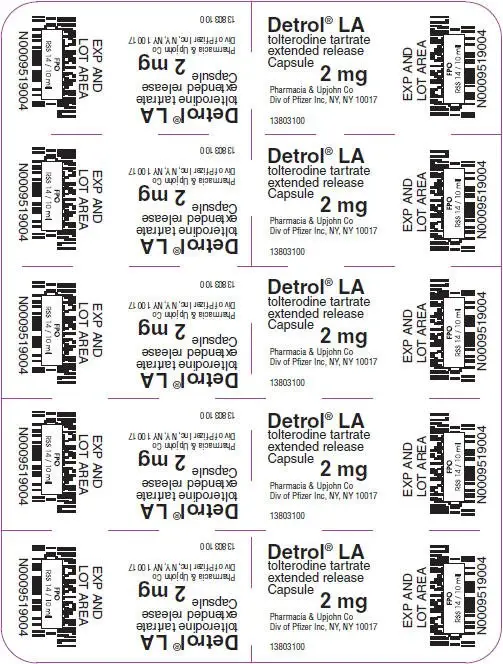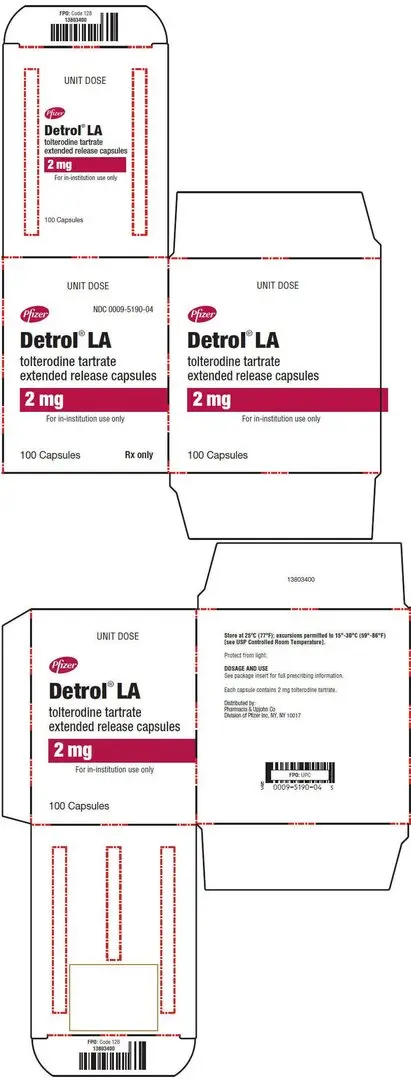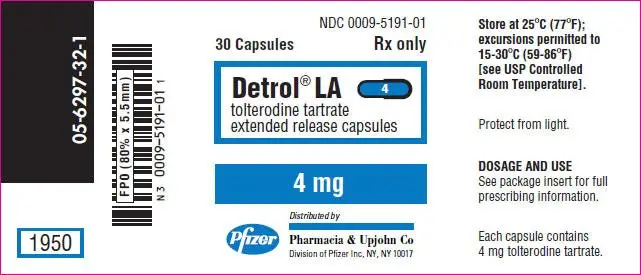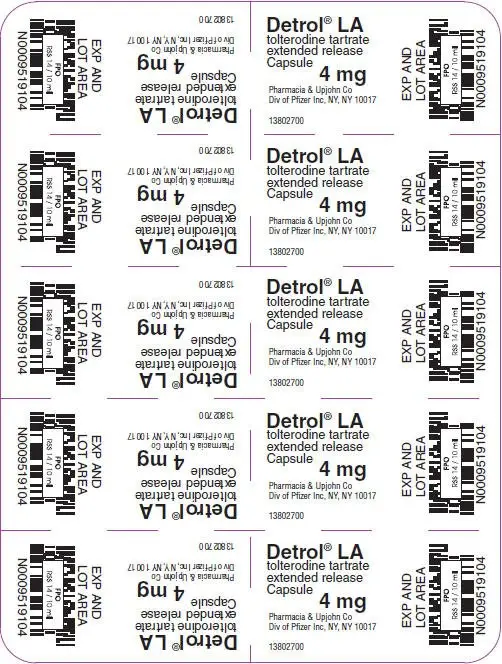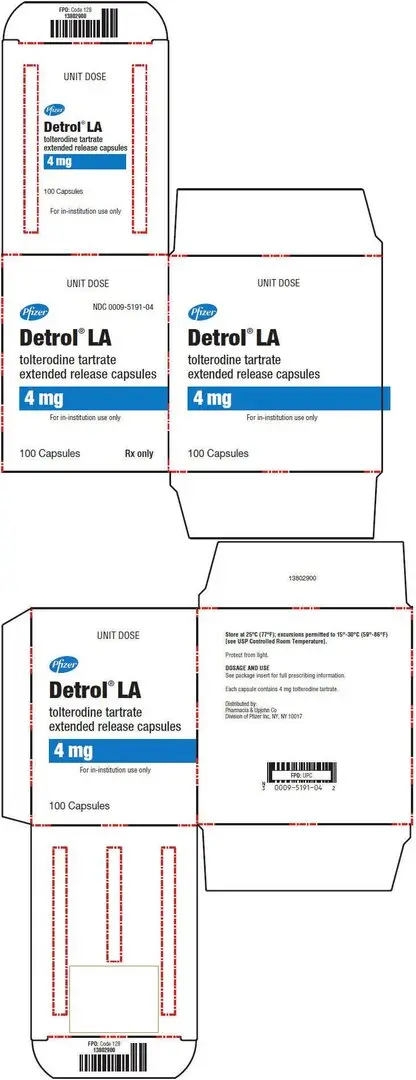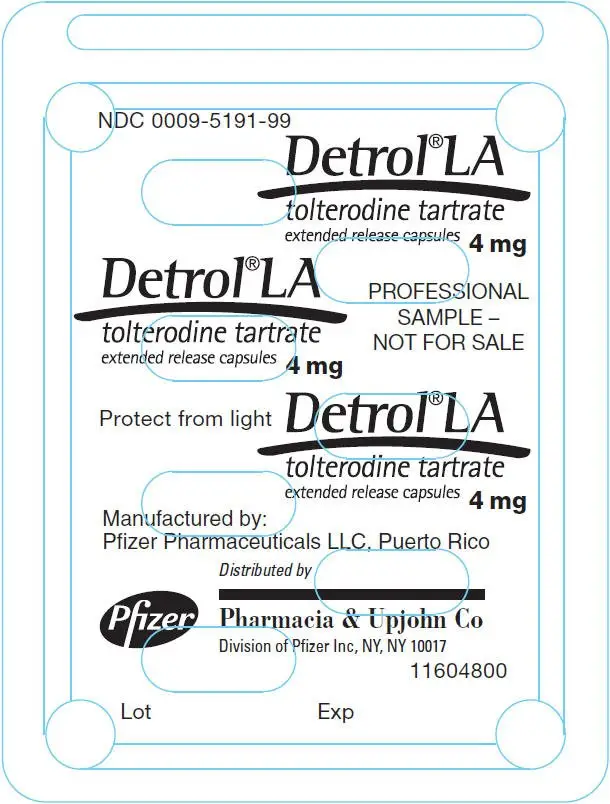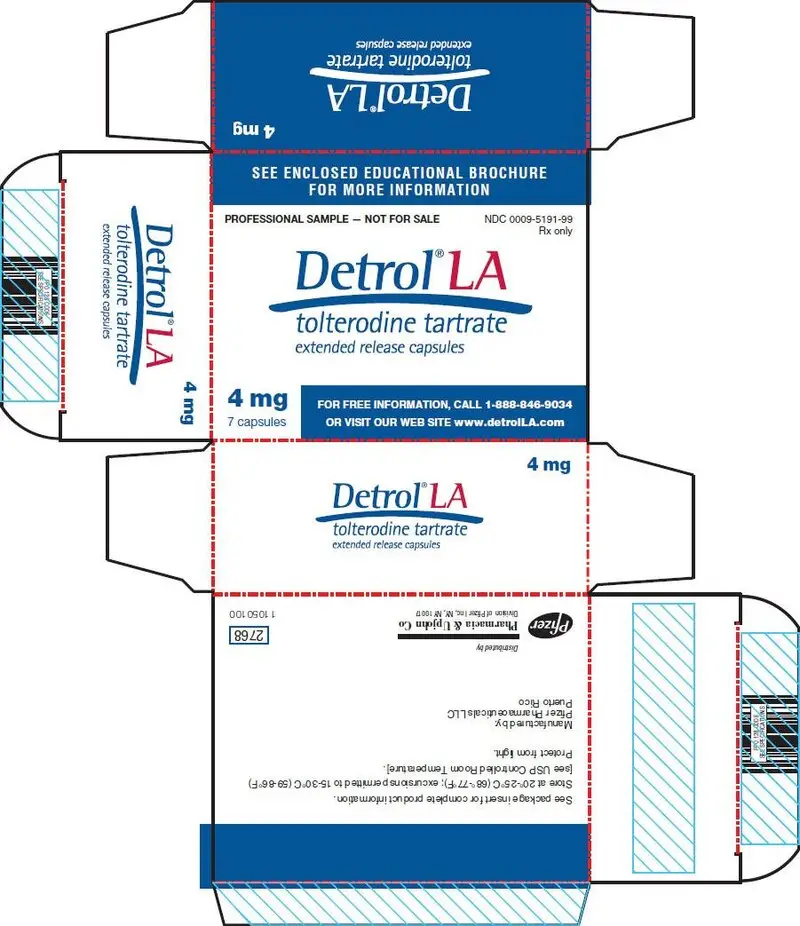Drug Detail:Detrol la (Tolterodine [ tol-ter-oh-deen ])
Drug Class: Urinary antispasmodics
Highlights of Prescribing Information
Detrol® LA (tolterodine tartrate extended release capsules)
For oral administration
Initial U.S. Approval: December 2000
Indications and Usage for Detrol LA
DETROL LA is an antimuscarinic indicated for the treatment of overactive bladder with symptoms of urge urinary incontinence, urgency, and frequency. (1)
Detrol LA Dosage and Administration
- 4 mg capsules taken orally once daily with water and swallowed whole. (2.1)
- 2 mg capsules taken orally once daily with water and swallowed whole in the presence of:
- mild to moderate hepatic impairment (Child-Pugh class A or B) (2.2)
- severe renal impairment [Creatinine Clearance (CCr) 10–30 mL/min] (2.2)
- drugs that are potent CYP3A4 inhibitors. (2.2)
- DETROL LA is not recommended for use in patients with CCr <10 mL/min. (2.2)
- DETROL LA is not recommended for use in patients with severe hepatic impairment (Child-Pugh Class C). (2.2)
Dosage Forms and Strengths
Capsules: 2 mg and 4 mg (3)
Contraindications
DETROL LA is contraindicated in patients with urinary retention, gastric retention, or uncontrolled narrow-angle glaucoma. DETROL LA is also contraindicated in patients with known hypersensitivity to the drug or its ingredients, or to fesoterodine fumarate extended-release tablets which, like DETROL LA, are metabolized to 5-hydroxymethyl tolterodine. (4)
Warnings and Precautions
- Anaphylaxis and angioedema requiring hospitalization and emergency medical treatment have occurred with the first or subsequent doses of DETROL LA. (5.1)
- Urinary Retention: use caution in patients with clinically significant bladder outflow obstruction because of the risk of urinary retention. (5.2)
- Gastrointestinal Disorders: use caution in patients with gastrointestinal obstructive disorders or decreased gastrointestinal motility because of the risk of gastric retention. (5.3)
- Controlled Narrow-Angle Glaucoma: use caution in patients being treated for narrow-angle glaucoma. (5.4)
- Central Nervous System Effects: Somnolence has been reported with Detrol LA. Advise patients not to drive or operate heavy machinery until they know how Detrol LA affects them (5.5).
- Myasthenia Gravis: use caution in patients with myasthenia gravis. (5.8)
- QT Prolongation: consider observations from the thorough QT study in clinical decisions to prescribe DETROL LA to patients with a known history of QT prolongation or to patients who are taking Class IA (e.g., quinidine, procainamide) or Class III (e.g., amiodarone, sotalol) antiarrhythmic medications. (5.9)
Adverse Reactions/Side Effects
The most common adverse reactions (incidence ≥4% and >placebo) were dry mouth, headache, constipation, and abdominal pain. (6.1)
To report SUSPECTED ADVERSE REACTIONS, contact Pfizer Inc at 1-800-438-1985 or FDA at 1-800-FDA-1088 or www.fda.gov/medwatch.
Drug Interactions
- Potent CYP3A4 Inhibitors: Coadministration may increase systemic exposure to DETROL LA. Reduce DETROL LA dose to 2 mg once daily. (7.2)
- Other Anticholinergics (antimuscarinics): Concomitant use with other anticholinergic agents may increase the frequency and/or severity of dry mouth, constipation, blurred vision, and other anticholinergic pharmacological effects. (7.6)
Use In Specific Populations
- Renal Impairment: DETROL LA is not recommended for use in patients with CCr <10 mL/min. Dose adjustment in severe renal impairment (CCr: 10–30 mL/min). (8.6)
- Hepatic Impairment: Not recommended for use in severe hepatic impairment (Child Pugh Class C). Dose adjustment in mild to moderate hepatic impairment (Child Pugh Class A, B). (8.7)
See 17 for PATIENT COUNSELING INFORMATION and FDA-approved patient labeling.
Revised: 7/2018
Full Prescribing Information
1. Indications and Usage for Detrol LA
DETROL LA Capsules is indicated for the treatment of overactive bladder with symptoms of urge urinary incontinence, urgency, and frequency [see CLINICAL STUDIES (14)].
2. Detrol LA Dosage and Administration
2.1 Dosing Information
The recommended dose of DETROL LA Capsules is 4 mg once daily with water and swallowed whole. The dose may be lowered to 2 mg daily based on individual response and tolerability; however, limited efficacy data are available for DETROL LA 2 mg [see CLINICAL STUDIES (14)].
2.2 Dosage Adjustment in Specific Populations
For patients with mild to moderate hepatic impairment (Child-Pugh Class A or B) or severe renal impairment (CCr 10–30 mL/min), the recommended dose of DETROL LA is 2 mg once daily. DETROL LA is not recommended for use in patients with severe hepatic impairment (Child-Pugh Class C). Patients with CCr<10 mL/min have not been studied and use of DETROL LA in this population is not recommended [see WARNINGS AND PRECAUTIONS (5.6) and USE IN SPECIFIC POPULATIONS (8.6, 8.7)].
3. Dosage Forms and Strengths
The 2 mg capsules are blue-green with symbol and 2 printed in white ink.
The 4 mg capsules are blue with symbol and 4 printed in white ink.
4. Contraindications
DETROL LA is contraindicated in patients with urinary retention, gastric retention, or uncontrolled narrow-angle glaucoma. DETROL LA is also contraindicated in patients with known hypersensitivity to the drug or its ingredients, or to fesoterodine fumarate extended-release tablets which, like DETROL LA, are metabolized to 5-hydroxymethyl tolterodine [see WARNINGS AND PRECAUTIONS (5.2) (5.3), (5.4)].
5. Warnings and Precautions
5.1 Angioedema
Anaphylaxis and angioedema requiring hospitalization and emergency medical treatment have occurred with the first or subsequent doses of DETROL LA. In the event of difficulty in breathing, upper airway obstruction, or fall in blood pressure, DETROL LA should be discontinued and appropriate therapy promptly provided.
5.2 Urinary Retention
Administer DETROL LA Capsules with caution to patients with clinically significant bladder outflow obstruction because of the risk of urinary retention [see CONTRAINDICATIONS (4)].
5.3 Gastrointestinal Disorders
Administer DETROL LA with caution in patients with gastrointestinal obstructive disorders because of the risk of gastric retention.
DETROL LA, like other antimuscarinic drugs, may decrease gastrointestinal motility and should be used with caution in patients with conditions associated with decreased gastrointestinal motility (e.g., intestinal atony) [see CONTRAINDICATIONS (4)].
5.4 Controlled Narrow-Angle Glaucoma
Administer DETROL LA with caution in patients being treated for narrow-angle glaucoma [see CONTRAINDICATIONS (4)].
5.5 Central Nervous System Effects
Detrol LA is associated with anticholinergic central nervous system (CNS) effects [see Adverse Reactions (6.2)] including dizziness and somnolence [see Adverse Reactions (6.1)]. Patients should be monitored for signs of anticholinergic CNS effects, particularly after beginning treatment or increasing the dose. Advise patients not to drive or operate heavy machinery until the drug's effects have been determined. If a patient experiences anticholinergic CNS effects, dose reduction or drug discontinuation should be considered.
5.6 Hepatic Impairment
The clearance of orally administered tolterodine immediate release was substantially lower in cirrhotic patients than in the healthy volunteers. For patients with mild to moderate hepatic impairment (Child-Pugh Class A or B), the recommended dose for DETROL LA is 2 mg once daily. DETROL LA is not recommended for use in patients with severe hepatic impairment (Child-Pugh Class C) [see DOSAGE AND ADMINISTRATION (2.2) and USE IN SPECIFIC POPULATIONS (8.6)].
5.7 Renal Impairment
Renal impairment can significantly alter the disposition of tolterodine and its metabolites. The dose of DETROL LA should be reduced to 2 mg once daily in patients with severe renal impairment (CCr: 10–30 mL/min). Patients with CCr<10 mL/min have not been studied and use of DETROL LA in this population is not recommended [see DOSAGE AND ADMINISTRATION (2.2) and USE IN SPECIFIC POPULATIONS (8.7)].
5.8 Myasthenia Gravis
Administer DETROL LA with caution in patients with myasthenia gravis, a disease characterized by decreased cholinergic activity at the neuromuscular junction.
5.9 Use in Patients with Congenital or Acquired QT Prolongation
In a study of the effect of tolterodine immediate release tablets on the QT interval [see CLINICAL PHARMACOLOGY (12.2)], the effect on the QT interval appeared greater for 8 mg/day (two times the therapeutic dose) compared to 4 mg/day and was more pronounced in CYP2D6 poor metabolizers (PM) than extensive metabolizers (EMs). The effect of tolterodine 8 mg/day was not as large as that observed after four days of therapeutic dosing with the active control moxifloxacin. However, the confidence intervals overlapped.
These observations should be considered in clinical decisions to prescribe DETROL LA to patients with a known history of QT prolongation or to patients who are taking Class IA (e.g., quinidine, procainamide) or Class III (e.g., amiodarone, sotalol) antiarrhythmic medications. There has been no association of Torsade de Pointes in the international post-marketing experience with DETROL or DETROL LA.
6. Adverse Reactions/Side Effects
Because clinical trials are conducted under widely varying conditions, adverse reaction rates observed in the clinical trials of a drug cannot be directly compared to rates in the clinical trials of another drug and may not reflect the rates observed in practice.
6.1 Clinical Trials Experience
The efficacy and safety of DETROL LA Capsules was evaluated in 1073 patients (537 assigned to DETROL LA; 536 assigned to placebo) who were treated with 2, 4, 6, or 8 mg/day for up to 15 months. These included a total of 1012 patients (505 randomized to DETROL LA 4 mg once daily and 507 randomized to placebo) enrolled in a randomized, placebo-controlled, double-blind, 12-week clinical efficacy and safety study.
Adverse events were reported in 52% (n=263) of patients receiving DETROL LA and in 49% (n=247) of patients receiving placebo. The most common adverse events reported by patients receiving DETROL LA were dry mouth, headache, constipation, and abdominal pain. Dry mouth was the most frequently reported adverse event for patients treated with DETROL LA, occurring in 23.4% of patients treated with DETROL LA and 7.7% of placebo-treated patients. Dry mouth, constipation, abnormal vision (accommodation abnormalities), urinary retention, and dry eyes are expected side effects of antimuscarinic agents. A serious adverse event was reported by 1.4% (n=7) of patients receiving DETROL LA and by 3.6% (n=18) of patients receiving placebo.
Table 1 lists the adverse events, regardless of causality, that were reported in the randomized, double-blind, placebo-controlled 12-week study at an incidence greater than placebo and in greater than or equal to 1% of patients treated with DETROL LA 4 mg once daily.
| Body System | Adverse Event | % DETROL LA n=505 | % Placebo n=507 |
|---|---|---|---|
|
|||
| Autonomic Nervous | dry mouth | 23 | 8 |
| General | headache | 6 | 5 |
| fatigue | 2 | 1 | |
| Central/Peripheral Nervous | dizziness | 2 | 1 |
| Gastrointestinal | constipation | 6 | 4 |
| abdominal pain | 4 | 2 | |
| dyspepsia | 3 | 1 | |
| Vision | xerophthalmia | 3 | 2 |
| vision abnormal | 1 | 0 | |
| Psychiatric | somnolence | 3 | 2 |
| anxiety | 1 | 0 | |
| Respiratory | sinusitis | 2 | 1 |
| Urinary | dysuria | 1 | 0 |
The frequency of discontinuation due to adverse events was highest during the first 4 weeks of treatment. Similar percentages of patients treated with DETROL LA or placebo discontinued treatment due to adverse events. Dry mouth was the most common adverse event leading to treatment discontinuation among patients receiving DETROL LA [n=12 (2.4%) vs. placebo n=6 (1.2%)].
6.2 Post-marketing Experience
The following events have been reported in association with tolterodine use in worldwide post-marketing experience:
General: anaphylaxis and angioedema; Cardiovascular: tachycardia, palpitations, peripheral edema; Gastrointestinal: diarrhea; Central/Peripheral Nervous: confusion, disorientation, memory impairment, hallucinations.
Reports of aggravation of symptoms of dementia (e.g., confusion, disorientation, delusion) have been reported after tolterodine therapy was initiated in patients taking cholinesterase inhibitors for the treatment of dementia.
Because these spontaneously reported events are from the worldwide post-marketing experience, the frequency of events and the role of tolterodine in their causation cannot be reliably determined.
7. Drug Interactions
7.1 Potent CYP2D6 Inhibitors
Fluoxetine, a potent inhibitor of CYP2D6 activity, significantly inhibited the metabolism of tolterodine immediate release in CYP2D6 extensive metabolizers, resulting in a 4.8-fold increase in tolterodine AUC. There was a 52% decrease in Cmax and a 20% decrease in AUC of 5-hydroxymethyl tolterodine (5-HMT), the pharmacologically active metabolite of tolterodine [see CLINICAL PHARMACOLOGY (12.1)]. The sums of unbound serum concentrations of tolterodine and 5-HMT are only 25% higher during the interaction. No dose adjustment is required when tolterodine and fluoxetine are co-administered [see CLINICAL PHARMACOLOGY (12.3)].
7.2 Potent CYP3A4 Inhibitors
Ketoconazole (200 mg daily), a potent CYP3A4 inhibitor, increased the mean Cmax and AUC of tolterodine by 2- and 2.5-fold, respectively, in CYP2D6 poor metabolizers.
For patients receiving ketoconazole or other potent CYP3A4 inhibitors such as itraconazole, clarithromycin, or ritonavir, the recommended dose of DETROL LA is 2 mg once daily [see DOSAGE AND ADMINISTRATION(2.2) and CLINICAL PHARMACOLOGY (12.3)].
7.3 Other Interactions
No clinically relevant interactions have been observed when tolterodine was co-administered with warfarin, with a combined oral contraceptive drug containing ethinyl estradiol and levonorgestrel, or with diuretics [see CLINICAL PHARMACOLOGY (12.3)].
7.4 Other Drugs Metabolized by Cytochrome P450 Isoenzymes
In vivo drug-interaction data show that tolterodine immediate release does not result in clinically relevant inhibition of CYP1A2, 2D6, 2C9, 2C19, or 3A4 as evidenced by lack of influence on the marker drugs caffeine, debrisoquine, S-warfarin, and omeprazole [see CLINICAL PHARMACOLOGY (12.3)].
8. Use In Specific Populations
8.2 Lactation
8.4 Pediatric Use
The effectiveness of DETROL LA has not been established in pediatric patients.
Efficacy was not established in two randomized, placebo-controlled, double-blind, 12-week studies that enrolled 710 pediatric patients (486 on DETROL LA, 224 on placebo) aged 5–10 years with urinary frequency and urge incontinence. The percentage of patients with urinary tract infections was higher in patients treated with DETROL LA (6.6%) compared to patients who received placebo (4.5%). Aggressive, abnormal, and hyperactive behavior and attention disorders occurred in 2.9% of children treated with DETROL LA compared to 0.9% of children treated with placebo.
8.5 Geriatric Use
No overall differences in safety were observed between the older and younger patients treated with tolterodine.
In multiple-dose studies in which tolterodine immediate release 4 mg (2 mg bid) was administered, serum concentrations of tolterodine and of 5-HMT were similar in healthy elderly volunteers (aged 64 through 80 years) and healthy young volunteers (aged less than 40 years). In another clinical study, elderly volunteers (aged 71 through 81 years) were given tolterodine immediate release 2 or 4 mg (1 or 2 mg bid). Mean serum concentrations of tolterodine and 5-HMT in these elderly volunteers were approximately 20% and 50% higher, respectively, than concentrations reported in young healthy volunteers. However, no overall differences were observed in safety between older and younger patients on tolterodine in the Phase 3, 12-week, controlled clinical studies; therefore, no tolterodine dosage adjustment for elderly patients is recommended.
8.6 Renal Impairment
Renal impairment can significantly alter the disposition of tolterodine immediate release and its metabolites. In a study conducted in patients with creatinine clearance between 10 and 30 mL/min, tolterodine and 5-HMT levels were approximately 2–3 fold higher in patients with renal impairment than in healthy volunteers. Exposure levels of other metabolites of tolterodine (e.g., tolterodine acid, N-dealkylated tolterodine acid, N-dealkylated tolterodine, and N-dealkylated hydroxy tolterodine) were significantly higher (10–30 fold) in renally impaired patients as compared to the healthy volunteers. The recommended dose for patients with severe renal impairment (CCr: 10–30 mL/min) is DETROL LA 2 mg daily. Patients with CCr<10 mL/min have not been studied and use of DETROL LA in this population is not recommended [see DOSAGE AND ADMINISTRATION (2.2) and WARNINGS AND PRECAUTIONS (5.6)]. DETROL LA has not been studied in patients with mild to moderate renal impairment [CCr 30–80 mL/min].
8.7 Hepatic Impairment
Liver impairment can significantly alter the disposition of tolterodine immediate release. In a study of tolterodine immediate release conducted in cirrhotic patients (Child-Pugh Class A and B), the elimination half-life of tolterodine immediate release was longer in cirrhotic patients (mean, 7.8 hours) than in healthy, young, and elderly volunteers (mean, 2 to 4 hours). The clearance of orally administered tolterodine immediate release was substantially lower in cirrhotic patients (1.0 ± 1.7 L/h/kg) than in the healthy volunteers (5.7 ± 3.8 L/h/kg). The recommended dose for patients with mild to moderate hepatic impairment (Child-Pugh Class A or B) is DETROL LA 2 mg once daily. DETROL LA is not recommended for use in patients with severe hepatic impairment (Child-Pugh Class C) [see DOSAGE AND ADMINISTRATION (2.2) and WARNINGS AND PRECAUTIONS (5.4)].
10. Overdosage
Overdosage with DETROL LA Capsules can potentially result in severe central anticholinergic effects and should be treated accordingly.
ECG monitoring is recommended in the event of overdosage. In dogs, changes in the QT interval (slight prolongation of 10% to 20%) were observed at a suprapharmacologic dose of 4.5 mg/kg, which is about 68 times higher than the recommended human dose. In clinical trials of normal volunteers and patients, QT interval prolongation was observed with tolterodine immediate release at doses up to 8 mg (4 mg bid) and higher doses were not evaluated [see WARNINGS AND PRECAUTIONS (5.9) and CLINICAL PHARMACOLOGY (12.2)].
A 27-month-old child who ingested 5 to 7 tolterodine immediate release 2 mg tablets was treated with a suspension of activated charcoal and was hospitalized overnight with symptoms of dry mouth. The child fully recovered.
11. Detrol LA Description
DETROL LA Capsules contain tolterodine tartrate. The active moiety, tolterodine, is a muscarinic receptor antagonist. The chemical name of tolterodine tartrate is (R)-N,N-diisopropyl-3-(2-hydroxy-5-methylphenyl)-3-phenylpropanamine L-hydrogen tartrate. The empirical formula of tolterodine tartrate is C26H37NO7,. Its structure is:
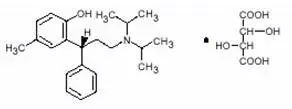
Tolterodine tartrate is a white, crystalline powder with a molecular weight of 475.6. The pKa value is 9.87 and the solubility in water is 12 mg/mL. It is soluble in methanol, slightly soluble in ethanol, and practically insoluble in toluene. The partition coefficient (Log D) between n-octanol and water is 1.83 at pH 7.3.
DETROL LA 4 mg capsule for oral administration contains 4 mg of tolterodine tartrate. Inactive ingredients are sucrose, starch, hypromellose, ethylcellulose, medium chain triglycerides, oleic acid, gelatin, and FD&C Blue #2.
DETROL LA 2 mg capsule for oral administration contains 2 mg of tolterodine tartrate, and the following inactive ingredients: sucrose, starch, hypromellose, ethylcellulose, medium chain triglycerides, oleic acid, gelatin, yellow iron oxide, and FD&C Blue #2.
Both the 2 mg and 4 mg capsule strengths are imprinted with a pharmaceutical grade printing ink that contains shellac glaze, titanium dioxide, propylene glycol, and simethicone.
12. Detrol LA - Clinical Pharmacology
12.1 Mechanism of Action
Tolterodine acts as a competitive antagonist of acetylcholine at postganglionic muscarinic receptors. Both urinary bladder contraction and salivation are mediated via cholinergic muscarinic receptors.
After oral administration, tolterodine is metabolized in the liver, resulting in the formation of 5-hydroxymethyl tolterodine (5-HMT), the major pharmacologically active metabolite. 5-HMT, which exhibits an antimuscarinic activity similar to that of tolterodine, contributes significantly to the therapeutic effect. Both tolterodine and 5-HMT exhibit a high specificity for muscarinic receptors, since both show negligible activity or affinity for other neurotransmitter receptors and other potential cellular targets, such as calcium channels.
12.2 Pharmacodynamics
Tolterodine has a pronounced effect on bladder function. Effects on urodynamic parameters before and 1 and 5 hours after a single 6.4 mg dose of tolterodine immediate release were determined in healthy volunteers. The main effects of tolterodine at 1 and 5 hours were an increase in residual urine, reflecting an incomplete emptying of the bladder, and a decrease in detrusor pressure. These findings are consistent with an antimuscarinic action on the lower urinary tract.
Cardiac Electrophysiology
The effect of 2 mg BID and 4 mg BID of DETROL immediate release (tolterodine IR) tablets on the QT interval was evaluated in a 4-way crossover, double-blind, placebo- and active-controlled (moxifloxacin 400 mg QD) study in healthy male (N=25) and female (N=23) volunteers aged 18–55 years. Study subjects [approximately equal representation of CYP2D6 extensive metabolizers (EMs) and poor metabolizers (PMs)] completed sequential 4-day periods of dosing with moxifloxacin 400 mg QD, tolterodine 2 mg BID, tolterodine 4 mg BID, and placebo. The 4 mg BID dose of tolterodine IR (two times the highest recommended dose) was chosen because this dose results in tolterodine exposure similar to that observed upon coadministration of tolterodine 2 mg BID with potent CYP3A4 inhibitors in patients who are CYP2D6 poor metabolizers [see DRUG INTERACTIONS (7.2)]. QT interval was measured over a 12-hour period following dosing, including the time of peak plasma concentration (Tmax) of tolterodine and at steady state (Day 4 of dosing).
Table 2 summarizes the mean change from baseline to steady state in corrected QT interval (QTc) relative to placebo at the time of peak tolterodine (1 hour) and moxifloxacin (2 hour) concentrations. Both Fridericia's (QTcF) and a population-specific (QTcP) method were used to correct QT interval for heart rate. No single QT correction method is known to be more valid than others. QT interval was measured manually and by machine, and data from both are presented. The mean increase of heart rate associated with a 4 mg/day dose of tolterodine in this study was 2.0 beats/minute and 6.3 beats/minute with 8 mg/day tolterodine. The change in heart rate with moxifloxacin was 0.5 beats/minute.
| Drug/Dose | N | QTcF (msec) (manual) | QTcF (msec) (machine) | QTcP (msec) (manual) | QTcP (msec) (machine) |
|---|---|---|---|---|---|
|
|||||
| Tolterodine 2 mg BID* | 48 | 5.01 (0.28, 9.74) | 1.16 (-2.99, 5.30) | 4.45 (-0.37, 9.26) | 2.00 (-1.81, 5.81) |
| Tolterodine 4 mg BID* | 48 | 11.84 (7.11, 16.58) | 5.63 (1.48, 9.77) | 10.31 (5.49, 15.12) | 8.34 (4.53, 12.15) |
| Moxifloxacin 400 mg QD † | 45 | 19.26‡
(15.49, 23.03) | 8.90 (4.77, 13.03) | 19.10‡
(15.32, 22.89) | 9.29 (5.34, 13.24) |
The reason for the difference between machine and manual read of QT interval is unclear.
The QT effect of tolterodine immediate release tablets appeared greater for 8 mg/day (two times the therapeutic dose) compared to 4 mg/day. The effect of tolterodine 8 mg/day was not as large as that observed after four days of therapeutic dosing with the active control moxifloxacin. However, the confidence intervals overlapped.
Tolterodine's effect on QT interval was found to correlate with plasma concentration of tolterodine. There appeared to be a greater QTc interval increase in CYP2D6 poor metabolizers than in CYP2D6 extensive metabolizers after tolterodine treatment in this study.
This study was not designed to make direct statistical comparisons between drugs or dose levels. There has been no association of Torsade de Pointes in the international post-marketing experience with DETROL or DETROL LA [see WARNINGS AND PRECAUTIONS (5.7)].
12.3 Pharmacokinetics
Excretion: Following administration of a 5 mg oral dose of 14C-tolterodine solution to healthy volunteers, 77% of radioactivity was recovered in urine and 17% was recovered in feces in 7 days. Less than 1% (< 2.5% in poor metabolizers) of the dose was recovered as intact tolterodine, and 5% to 14% (<1% in poor metabolizers) was recovered as 5-HMT.
A summary of mean (± standard deviation) pharmacokinetic parameters of tolterodine extended release and 5-HMT in extensive (EM) and poor (PM) metabolizers is provided in Table 3. These data were obtained following single and multiple doses of tolterodine extended release administered daily to 17 healthy male volunteers (13 EM, 4 PM).
| Tolterodine | 5-Hydroxymethyl Tolterodine | |||||||
|---|---|---|---|---|---|---|---|---|
| tmax*
(h) | Cmax
(µg/L) | Cavg
(µg/L) | t½
(h) | tmax*
(h) | Cmax
(µg/L) | Cavg
(µg/L) | t½
(h) |
|
| Cmax = Maximum serum concentration; tmax = Time of occurrence of Cmax; | ||||||||
| Cavg = Average serum concentration; t1/2 = Terminal elimination half-life. | ||||||||
|
||||||||
| Single dose 4 mg† | ||||||||
| EM | 4(2–6) | 1.3(0.8) | 0.8(0.57) | 8.4(3.2) | 4(3–6) | 1.6(0.5) | 1.0(0.32) | 8.8(5.9) |
| Multiple dose 4 mg | ||||||||
| EM | 4(2–6) | 3.4(4.9) | 1.7(2.8) | 6.9(3.5) | 4(2–6) | 2.7(0.90) | 1.4(0.6) | 9.9(4.0) |
| PM | 4(3–6) | 19(16) | 13(11) | 18(16) | ‡ | ‡ | ‡ | ‡ |
13. Nonclinical Toxicology
13.1 Carcinogenesis, Mutagenesis, Impairment of Fertility
Carcinogenicity studies with tolterodine were conducted in mice and rats. At the maximum tolerated dose in mice (30 mg/kg/day), female rats (20 mg/kg/day), and male rats (30 mg/kg/day), exposure margins were approximately 6–9 times, 7 times, and 11 times the clinical exposure to the pharmacologically active components of DETROL LA (based on AUC of tolterodine and its 5-HMT metabolite). At these exposure margins, no increase in tumors was found in either mice or rats.
No mutagenic or genotoxic effects of tolterodine were detected in a battery of in vitro tests, including bacterial mutation assays (Ames test) in 4 strains of Salmonella typhimurium and in 2 strains of Escherichia coli, a gene mutation assay in L5178Y mouse lymphoma cells, and chromosomal aberration tests in human lymphocytes. Tolterodine was also negative in vivo in the bone marrow micronucleus test in the mouse.
In female mice treated for 2 weeks before mating and during gestation with 20 mg/kg/day (about 9–12 times the clinical exposure via AUC), neither effects on reproductive performance or fertility were seen. In male mice, a dose of 30 mg/kg/day did not induce any adverse effects on fertility.
14. Clinical Studies
DETROL LA Capsules 2 mg were evaluated in 29 patients in a Phase 2 dose-effect study. DETROL LA 4 mg was evaluated for the treatment of overactive bladder with symptoms of urge urinary incontinence and frequency in a randomized, placebo-controlled, multicenter, double-blind, Phase 3, 12-week study. A total of 507 patients received DETROL LA 4 mg once daily in the morning and 508 received placebo. The majority of patients were Caucasian (95%) and female (81%), with a mean age of 61 years (range, 20 to 93 years). In the study, 642 patients (42%) were 65 to 93 years of age. The study included patients known to be responsive to tolterodine immediate release and other anticholinergic medications, however, 47% of patients never received prior pharmacotherapy for overactive bladder. At study entry, 97% of patients had at least 5 urge incontinence episodes per week and 91% of patients had 8 or more micturitions per day.
The primary efficacy assessment was change in mean number of incontinence episodes per week at week 12 from baseline. Secondary efficacy measures included change in mean number of micturitions per day and mean volume voided per micturition at week 12 from baseline.
Patients treated with DETROL LA experienced a statistically significant decrease in number of urinary incontinence per week from baseline to last assessment (week 12) compared with placebo as well as a decrease in the average daily urinary frequency and an increase in the average urine volume per void.
Mean change from baseline in weekly incontinence episodes, urinary frequency, and volume voided between placebo and DETROL LA are summarized in Table 4.
| DETROL LA (n=507) | Placebo (n=508)† | Treatment Difference, vs. Placebo (95% Cl) |
|
|---|---|---|---|
| SD = Standard Deviation. | |||
|
|||
| Number of incontinence episodes/ week Mean Baseline Mean Change from Baseline | 22.1 –11.8 (SD 17.8) | 23.3 –6.9 (SD 15.4) | -4.8‡
(–6.9, –2.8) |
| Number of micturitions/day Mean Baseline Mean Change from Baseline | 10.9 –1.8 (SD 3.4) | 11.3 –1.2 (SD 2.9) | -0.6‡
(–1.0, –0.2) |
| Volume voided per micturition (mL) Mean Baseline Mean Change from Baseline | 141 34 (SD 51) | 136 14 (SD 41) | 20‡
(14, 26) |
16. How is Detrol LA supplied
DETROL LA Capsules are supplied as follows:
| Bottles of 30 | Bottles of 500 | ||
| 2 mg Capsules | NDC 0009-5190-01 | 2 mg Capsules | NDC 0009-5190-03 |
| 4 mg Capsules | NDC 0009-5191-01 | 4 mg Capsules | NDC 0009-5191-03 |
| Bottles of 90 | Unit Dose Blisters | ||
| 2 mg Capsules | NDC 0009-5190-02 | 2 mg Capsules | NDC 0009-5190-04 |
| 4 mg Capsules | NDC 0009-5191-02 | 4 mg Capsules | NDC 0009-5191-04 |
| DETROL LA
tolterodine tartrate capsule, extended release |
|||||||||||||||||||||||||||||||||||
|
|||||||||||||||||||||||||||||||||||
|
|||||||||||||||||||||||||||||||||||
|
|||||||||||||||||||||||||||||||||||
|
|||||||||||||||||||||||||||||||||||
|
|||||||||||||||||||||||||||||||||||
|
|||||||||||||||||||||||||||||||||||
| DETROL LA
tolterodine tartrate capsule, extended release |
||||||||||||||||||||||||||||||||||||||||
|
||||||||||||||||||||||||||||||||||||||||
|
||||||||||||||||||||||||||||||||||||||||
|
||||||||||||||||||||||||||||||||||||||||
|
||||||||||||||||||||||||||||||||||||||||
|
||||||||||||||||||||||||||||||||||||||||
|
||||||||||||||||||||||||||||||||||||||||
| Labeler - Pharmacia and Upjohn Company LLC (618054084) |
| Establishment | |||
| Name | Address | ID/FEI | Business Operations |
|---|---|---|---|
| Pfizer Pharmaceuticals LLC | 829084545 | ANALYSIS(0009-5190, 0009-5191) , API MANUFACTURE(0009-5190, 0009-5191) , PACK(0009-5190, 0009-5191) | |
| Establishment | |||
| Name | Address | ID/FEI | Business Operations |
|---|---|---|---|
| NEOLPHARMA, INC. | 078709787 | ANALYSIS(0009-5190, 0009-5191) , API MANUFACTURE(0009-5190, 0009-5191) , LABEL(0009-5190, 0009-5191) , MANUFACTURE(0009-5190, 0009-5191) , PACK(0009-5190, 0009-5191) | |
| Establishment | |||
| Name | Address | ID/FEI | Business Operations |
|---|---|---|---|
| Pfizer Pharmaceuticals LLC | 829084552 | PACK(0009-5191, 0009-5190) | |
| Establishment | |||
| Name | Address | ID/FEI | Business Operations |
|---|---|---|---|
| Pharmacia and Upjohn Company LLC | 618054084 | ANALYSIS(0009-5190, 0009-5191) , API MANUFACTURE(0009-5190, 0009-5191) | |







